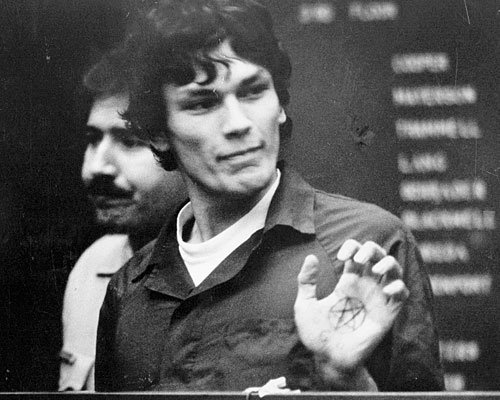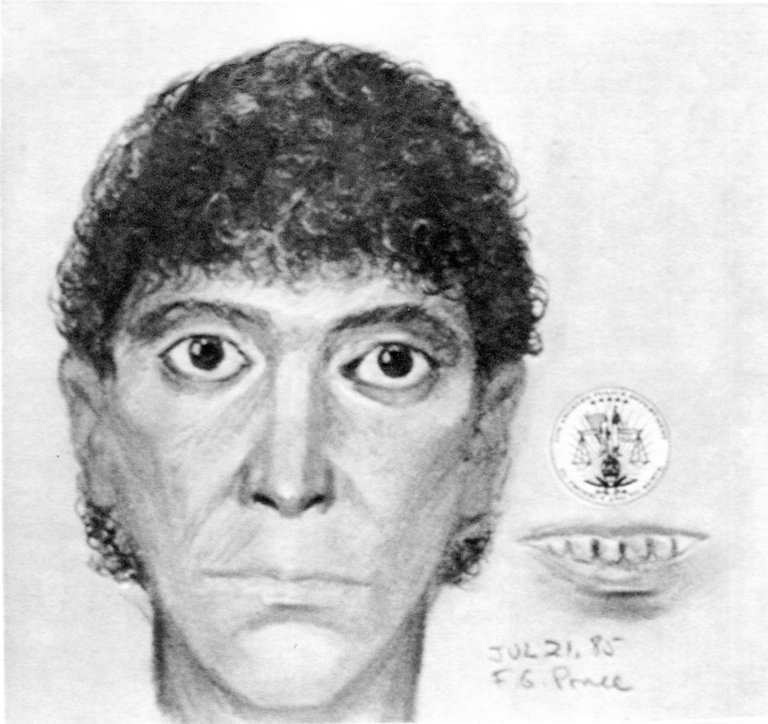What is Evil?
Evil would seem to be the life of Ricardo ‘Richard’ Ramirez, convicted murderer of 13 people and self-styled Satanist. In spite of his Catholic upbringing, he took to robbing, raping and mutilating his way around America.

Richard Ramirez’s life was destined to be one of extremes. He was born to Julian, a poor Mexican from a farming family, and Mercedes, an American citizen who lived with Julian in Mexico for a time. Living in the Mexican/American border town of El Paso, from the very beginning the American Dream of happiness, health, safety and prosperity was dangled like a crucifix in front of the Ramirez family’s eyes: believe and be rewarded. Unfortunately, though, it was always just out of their reach, along with their access to the blessings granted by its governmental authorities, be they of the immigration laws of the prosperous country or the supposed powers of their church. This led to a sense of eternal frustration for Richard’s family. They were at the mercy of a system that stalked them even as they tried to exercise their supposed right to move up the ranks of society.
Julian, Richard’s father, was extremely hard working but lacked an education, while his wife came from ‘better stock’ and expected a little more of the unearned privilege of bounty. He placed his faith primarily on the notions of tradition and honour, she on the justice of Jesus Christ, a figure omnipresent even today, decked out in gold in the slums of the country. As Julian found jobs to support his family over the border, immigration police intervened and dumped the family back into desperation, leaving Julian to defend their meagre possessions against bandits, while his wife was forced to trudge back across the perimeter. Nevertheless, while Jesus stood silent, the parents were determined and they worked and whirled in increasing circles on their way to a better future. ‘Circles’ was, sadly, the operative word; in a cruel twist of fate, the couple’s home in El Paso lay in the path of mighty winds from Los Alamos, New Mexico, where the US government were testing nuclear weapons. Several of the children were born with disabilities like Collier’s disease, which causes the bones to grow in curves and prevents movement. The family were stationed at hospital beds through the blazing summers. Despite their close knit nature in times of illness, the friction was fractious and hampered their future success before they’d even started.
Richard was to decide, based in part on these formative experiences, that what the Lord wouldn’t give, he, Richard, would taketh anyway.

The sign of cross alone is not enough to help a gaggle of squalling kids, and the Ramirez household was built on tried, tested and, some may say, exhausted family values. If Richard or any of his other siblings misbehaved, Julian would thrash them. These were not the taps of a tough father, but the belt-borne wallops of a man who was forced by his circumstances to work in physically demanding jobs that upset his psyche. Working on the railroad, for instance, gave him honour, but separated him from his family, giving him a ferocious temper. He felt he would get his just desserts when his children made him proud and carried on his family name, but for all Mercedes tried to be the perfect and dutiful wife, they were not favoured by the American god. Despite her prayers, his tempers came. The kids learned to be nimble to get away, but Richard did more than that: Richard danced.
Richie, as he was known, had not been like the other children. He was the baby, He was doted on by his older sister, Ruth, and unlike his older brothers, he was not much of a rabble rouser. He was a handsome, quick-witted child who loved to escape in the beat of his own imagination. Even as a baby, he would wiggle his body to the music and would go on to drive babysitters mad with his constant mental and physical action. This would not have been such as problem, but for the circumstances the Ramirez family found themselves in.
Having finally gained visas, they were able to escape to America and live among other poor Mexican immigrants in a community rife with drugs. Thus, happy Richie was dabbling in dope by the time he was ten, copying his older siblings, much to the anger of their strict father. Julian enjoyed physical labour and his muscular body was blessed by work, but would nonetheless become motionless at home. There were, however, occasions where he could not bend the objects bestowed on him (through work) to his will and he would terrify his family by repeatedly and rhythmically beating at his own head with a hammer if something as minor as a bit of home DIY went against him. Mercy-seeking Mercedes would turn away to ‘Jesu’ while her children ran and cowered in terror.
Richie took to sleeping in a local graveyard, finding it more peaceful than at home. He even found the visions of monsters he experienced there fascinating (unlike the fearsome man back home), not realising they were the likely indicators of grand mal epilepsy, which would lead to his bitter eventual exclusion from a school football team. He thought these visions were either messengers or messages; divine intervention from beyond, a sign that he had been chosen.

Deliverance was, however, not the standard life path for Mexican immigrant families, and while they had to shift for themselves, there was an increasing feeling that they shouldn’t have to work their fingers to the bone to achieve a decent life. As such, Richie’s older sibling began to find himself in trouble. Reuben earned a beating from their belligerent father after being caught stealing a car, and the children grew increasingly resentful of their mentally and physically absent parent. Richie, too, began to fall away, running off into a world of his own – much to the delight of his mother, who saw it as sign of an active imagination.
Angeles. His older brother, Reuben, had moved there and found it to be a place rich in pickings for the robber who was able to remain undetected. Richie was enthralled, not least by the rampant sexuality on show. Here there were not Hail Marys but hookers (as he saw them) on street corners, and he became a regular at the ‘XXX’ shops stocking hard core sadomasochistic porn that emphasised the subordination of women. With violence and power irrevocably fused in his psyche, the inevitable escalation into physical crime was first evidenced by the assault of a woman he’d watched from afar. It was the beginning of the reign of The Night Stalker.
As far as Richie was concerned, if God was not going to give him what he felt his family deserved, he would dance with the devil. It is not clear whether he viewed this Satan in the very physical way his mother perceived her Jesus, or as an ideal that could condone his violent visions, approve of his worship of heavy metal music and sanctify his superiority and sadism. Either way, Richie decided he wanted to achieve through evil, finding that its supposed mores fit more with what felt like his outré but honest nature.
His killings began on the morning of 27 June 1984 and would become a pattern. He would dress entirely in black and use the cover of night and the freeway to grant him anonymity. He would stalk random strangers. It led to his moniker, The Night Stalker. Breaking into their homes, he would kill the men and sexually assault the women, sodomise the children, once daubing inartful Satanic symbols across the walls and the body of one of his victims.
He was nailed to the crimes partly thanks to his belief that Satan would obscure him from public view, partly thanks to his boogie shoes: he was linked to footprints left by his sneakers, after which his face and descriptions were splashed across the mass media and a mob came baying for his blood. Ramirez was convicted of killing 13 people, but what also caught the nation’s attention were his court appearances.
Following in the footsteps of Satanic leader and ex-carnival worker Anton LaVey, he would at one moment display his so-called inner evil, yelling at the judge and a displaying a primitive pentagram inked on his clawed hand while flashing a rakish grin. At other times, he would argue that his trial was unsound. This statuesque man was accused of some of the most nauseating crimes it is possible to commit, yet he apparently loved this tango with the media, which he used to exploit his chivalrous side. And he did have one. This is a man, after all, who broke up with a former girlfriend rather than pressure or force her into engaging in acts she was uncomfortable with. While this may sound an obvious moral choice, particularly to the modern reader, the notion of conjugal rights – the expectation of sexual activity between partners – is still somewhat embedded within many societies.

Of key interest in terms of his actual nature is an interview with reporter Mike Watkiss while he was in custody. In it, Ramirez appears to conflate a basic sense of narcissistic showmanship in delivering pre-prepared speeches with his expression of philosophical theories about why he committed his crimes. While sometimes stating that he would not answer questions about his beliefs, he immediately ‘established’ himself as an expert on them with the phrase, “I can tell you a little bit about Satanism”. Then, in one breath, he stated: “A Satanist admits to being evil…. We are all evil in some form or another, are we not? [...] Yes, I am evil. Not 100 per cent, but I am evil.” This would seem to suggest he saw evil not simply as choosing to be amoral or being completely amoral by nature or indeed even being cruel (and immoral), but having the capacity to behave in what would be considered an amoral way some of the time. The sheer capacity for all human beings to act in what could be considered an amoral manner some of the time in the context of his argument therefore suggests he saw himself simply as more ‘evil’ than the average person. This explains one of his further comments, “Killing is killing, whether done for profit or fun. Men murder themselves into this democracy”. The basic comparison he uses here literally suggests that by stripping the details of how the killing is committed – the ‘how evil’ they are – from the deaths, the act of killing becomes ultimately similarly amoral, something done as a means to an end that may (in circumstances such as the Vietnam war that his cousin was involved in) be considered understandable, if not necessarily laudable. This explains his statement, “Evil has always existed. The perfect world most people seek shall never come to pass. And it’s gonna get worse”, purely on the basis that the vile actions will continue to be committed.
The distinction between his philosophy and Satanism itself can be seen in his phrases, “A Satanist admits to being evil” and “we gain the courage to rebaptise our evil qualities as being our best qualities”. By referring to the particularly Christian concept of Baptism (and particularly remembering Richie Ramirez was raised as a staunch Catholic), he is talking instead about trying to be bad rather than simply not judging behaviours. Most modern branches of Satanism aim to enable the believer to achieve their true desires and escape the unnecessarily constraining shackles of supposedly conventional morality, rather than trying to be cruel for the sake of it. Ramirez was many things, but he was not a Satanist in the true, modern sense of the term.
He used the idea of evil to justify the way it was easier for him to live considering his potential mental and physical health diagnosis. Quite simply, being considered ‘evil’ gave him a level of recognition, and indeed fame, that is a practical inversion of the American Dream, an ideal to which he was subscribed but could not participate. As a result, like serial killers such as Edmund Kemper, it could be argued that he chose to use the obvious intelligence suggested by his vocabulary in phrases such as “[Satanism] is undefiled wisdom instead of hypocritical self deceit. It is power without charity” to leverage what little power he could, even if only over the person conducting a seven minute television interview. He was determined to be seen not only as a someone, but as a prophet for his particular and peculiar strand of Satanic belief and all that might entail.
Richard Ramirez spent his life spinning between feelings of defiance towards the God he felt would shun him and deference to the ideas of the American Dream he believed God would bestow on the worthy. His early childhood was a liturgy of his parents’ prayers that their hard work would be rewarded, all the while they flailed against further and further setbacks over time, owing to their health, nationality and background. Richie and his siblings coped as best they could, but often faced with the silent Holy Father, rather than a reliable father figure, they composed their own morality.
Richie’s fused tales of war heroes with his own fevered, epileptic visions to give him the stark view of a world where success was only possible for him in infamy. The result was The Night Stalker, a character who could only dance to the beat of his own drum – the band leader he was looking for was never there to begin with.
I like writing about crime and criminals. All of my work is based on real stories. If you liked the article, please upvote and resteem it so that others can read it. For more of these, consider following me :)
I remember being terrified, as a kid in California, when he was on the loose. Really good write up.
I spotted this creepy graffiti in Rome, Italy. The Night Stalker is famous all over the world, apparently.
Congratulations @nopromises! You have completed some achievement on Steemit and have been rewarded with new badge(s) :
Click on any badge to view your own Board of Honnor on SteemitBoard.
For more information about SteemitBoard, click here
If you no longer want to receive notifications, reply to this comment with the word
STOPBy upvoting this notification, you can help all Steemit users. Learn how here!